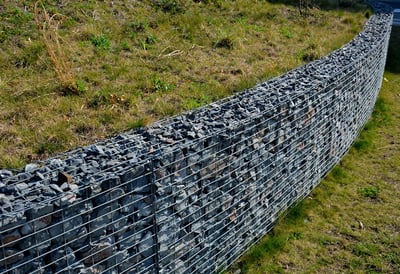Understanding Soil Erosion
Soil erosion refers to the process of the top layer of soil being worn away by natural factors such as wind, water, and gravity. It is a natural process that has been occurring for millions of years, but human activities have significantly accelerated it.
Understanding the causes and mechanisms of soil erosion is crucial in developing effective erosion control strategies. Factors such as rainfall intensity, slope steepness, vegetation cover, and soil characteristics all play a role in determining the rate and severity of erosion.
Soil erosion can have detrimental effects on the environment, agriculture, and infrastructure. It leads to the loss of fertile topsoil, which is essential for plant growth and agriculture. The eroded soil can also end up in water bodies, causing water pollution and sedimentation. Additionally, soil erosion can result in the formation of gullies and landslides, posing a threat to human settlements and infrastructure. Constructing gabions with the FASCO® (a BECK brand) F CL45A GABION tool and hog rings is a solid solution!
By understanding soil erosion, we can develop and implement effective erosion control measures to mitigate its negative impacts and protect our natural resources.
The Impact of Soil Erosion
Soil erosion can have severe consequences on the environment, agriculture, and society as a whole.
One of the primary impacts of soil erosion is the loss of fertile topsoil, which is essential for plant growth. This can lead to reduced agricultural productivity and food scarcity. The eroded soil also carries away valuable nutrients and organic matter, further degrading the soil quality.
Another significant impact of soil erosion is water pollution and sedimentation. When eroded soil particles enter water bodies, they can impair water quality, harming aquatic ecosystems and reducing the availability of clean water for human use.
Soil erosion can also lead to the formation of gullies and landslides, posing a threat to human settlements, infrastructure, and even lives. These natural disasters can cause property damage, disrupt transportation networks, and result in the loss of valuable resources.
It is crucial to address soil erosion and its impacts to ensure the sustainability of our environment, food production, and overall well-being.
What is Erosion Control?
Erosion control refers to the implementation of techniques and practices aimed at preventing or reducing soil erosion. It involves the management of factors that contribute to erosion, such as water flow, wind speed, and land use. Techniques can include the use of vegetation, such as planting trees and grasses, to stabilize the soil and reduce surface runoff. Other methods involve creating physical barriers, such as retaining walls and terraces, to redirect water flow and prevent erosion.
It is essential to tailor erosion control strategies to the specific conditions and needs of each site. By implementing effective erosion control measures, we can safeguard our soil resources and promote long-term environmental sustainability.
Effective Erosion Control Techniques
One of the most commonly used techniques is the establishment of vegetation cover. Planting trees, grasses, and other ground cover helps to stabilize the soil, reduce surface runoff, and enhance infiltration. The roots of plants bind the soil particles together, preventing them from being easily washed or blown away.
Terracing is another effective erosion control technique, especially on sloping terrains. It involves creating level or gently sloping platforms on the hillside, which help to slow down water flow and prevent soil erosion. Terraces can be constructed using various materials, such as rocks, timber, or concrete.
Retaining walls are often used in areas where there is a significant elevation difference. These structures help to hold back soil and prevent it from being washed away by water runoff. Retaining walls can be made from varied materials, including concrete, stone, or timber.
Other erosion control techniques include the use of erosion control blankets or mats, mulching, and installing sediment barriers or silt fences. Each technique has its advantages and suitability depending on the specific site conditions and erosion risks.
The Benefits of Implementing Erosion Control
One of the primary benefits is the preservation of soil fertility. By preventing soil erosion, we can retain the nutrient-rich topsoil that is essential for plant growth. This helps to maintain agricultural productivity, ensuring an adequate food supply for present and future generations.
Erosion control also contributes to water quality improvement. By reducing sedimentation and the entry of pollutants into water bodies, it helps to protect aquatic ecosystems and maintain the availability of clean water for various purposes, including drinking, irrigation, and recreation.
Furthermore, erosion control measures can help prevent the occurrence of landslides and gullies, which can pose significant risks to human lives, settlements, and infrastructure. By stabilizing the soil and managing water flow, erosion control techniques minimize the chances of these natural disasters.
Implementing erosion control not only benefits the environment and agriculture but also provides economic advantages. By preserving soil fertility and productivity, it reduces the need for excessive fertilizers and other inputs, resulting in cost savings for farmers. It also helps to prevent property damage and infrastructure disruptions caused by erosion-related disasters.
BECK has the system to build gabions where there’s a high probability of soil erosion. Use our  FASCO® F-CL45A-GABION tool and hog rings for a solid, stable, method of building erosion control solutions such as channel linings, slope stabilization, and retaining walls. Gabion walls are cheaper, much stronger, and quicker to install than any other rock wall. They can also be made aesthetically pleasing as to not take away from the beauty of nature.
FASCO® F-CL45A-GABION tool and hog rings for a solid, stable, method of building erosion control solutions such as channel linings, slope stabilization, and retaining walls. Gabion walls are cheaper, much stronger, and quicker to install than any other rock wall. They can also be made aesthetically pleasing as to not take away from the beauty of nature.
By prioritizing erosion control and implementing effective measures, we can protect our natural resources, promote sustainable development, and ensure a better future for generations to come. BECK has your solution for protecting our environment!
👇CLICK BELOW👇 to watch the Gabion System in action.
.svg.png)

